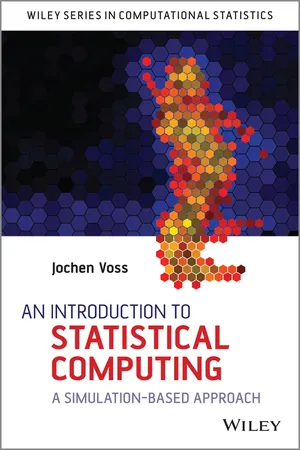
- English
- ePUB (mobile friendly)
- Available on iOS & Android
About this book
The use of computers in mathematics and statistics has opened up a wide range of techniques for studying otherwise intractable problems. Sampling-based simulation techniques are now an invaluable tool for exploring statistical models. This book gives a comprehensive introduction to the exciting area of sampling-based methods.
An Introduction to Statistical Computing introduces the classical topics of random number generation and Monte Carlo methods. It also includes some advanced methods such as the reversible jump Markov chain Monte Carlo algorithm and modern methods such as approximate Bayesian computation and multilevel Monte Carlo techniques
An Introduction to Statistical Computing:
- Fully covers the traditional topics of statistical computing.
- Discusses both practical aspects and the theoretical background.
- Includes a chapter about continuous-time models.
- Illustrates all methods using examples and exercises.
- Provides answers to the exercises (using the statistical computing environment R); the corresponding source code is available online.
- Includes an introduction to programming in R.
This book is mostly self-contained; the only prerequisites are basic knowledge of probability up to the law of large numbers. Careful presentation and examples make this book accessible to a wide range of students and suitable for self-study or as the basis of a taught course.
Frequently asked questions
- Essential is ideal for learners and professionals who enjoy exploring a wide range of subjects. Access the Essential Library with 800,000+ trusted titles and best-sellers across business, personal growth, and the humanities. Includes unlimited reading time and Standard Read Aloud voice.
- Complete: Perfect for advanced learners and researchers needing full, unrestricted access. Unlock 1.4M+ books across hundreds of subjects, including academic and specialized titles. The Complete Plan also includes advanced features like Premium Read Aloud and Research Assistant.
Please note we cannot support devices running on iOS 13 and Android 7 or earlier. Learn more about using the app.
Information

Table of contents
- Cover
- Series Page
- Title Page
- Copyright Page
- List of Algorithms
- Preface
- Nomenclature
- 1: Random number generation
- 2: Simulating statistical models
- 3: Monte Carlo methods
- 4: Markov Chain Monte Carlo methods
- 5: Beyond Monte Carlo
- 6: Continuous-time models
- Appendix A: Probability reminders
- Appendix B: Programming in R
- Appendix C: Answers to the exercises
- References
- Index